





There are few more impressive trees that are as care-free, magnificently flowered and are living works of southwestern-landscape art all at the same time, as are the solitary tree aloes. There are dozens of tree aloe species and all have their unique flowers, leaves and statements to make. The following article is a brief description of some of the solitary tree aloes (those with a single trunk and no branches) in cultivation, including flower description, some notes on cultivation, and some discussion on how to tell them apart. Part 2 will be a discussion of the tree aloes that branch (later article).
What is a tree aloe? For the purposes of this article, any aloe with a 'significant' solitary stem/trunk (over 3' tall) is considered a tree aloe.
There are many skinny, tall aloes made up of a complex of branches and suckers, but these are shrubby or vining plants, and don't have what one could call a trunk. And some aloes form a 'mini-trunk' up to nearly 3' tall, but those will be left out of this discussion. Conversely, some tree aloes are rarely seen by many growers as trees, either because they grow so slowly, or because conditions are just not right where the grower is living for the plant to form a trunk and then be called a tree. Admittedly the cut-off between a shrub and a tree is somewhat arbitrary, but fortunately there are very few aloes that 'sit on the fence' between the two.
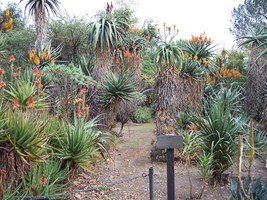 a view of some tree aloes in winter in the Huntington Gardens, one of the world's best collection of tree aloes
a view of some tree aloes in winter in the Huntington Gardens, one of the world's best collection of tree aloes
Where are tree aloes from? With a few exceptions, aloes are native to Africa or the islands off Africa (such as Madagascar). However, at least 1 tree aloe is a native of Yemen, which is officially considered part of Asia, though included on most maps of Africa.
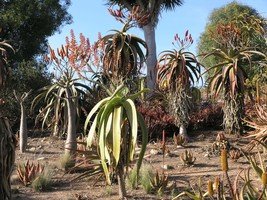 winter blooming tree aloes in private garden- the one in the foreground (Aloe sabaea) is from Asia, while all the others (Aloe excelsas) are from Africa
winter blooming tree aloes in private garden- the one in the foreground (Aloe sabaea) is from Asia, while all the others (Aloe excelsas) are from Africa
What climate do tree aloes grow in? Again, with few exceptions, most tree aloes grow best in warm, dry, arid, climates. A few can perform well in humid climates, but these are exceptional plants. Most tree aloes tolerate a good deal of frost, though some are less hardy than others. But as a group, the unbranching tree aloes, particularly those from South Africa, are quite cold hardy, at least down to about 25F. Those from Madagascar are a bit less cold hardy, but still most tolerate some frost and have little damage until temps get below 28F. With about 3-4 exceptions the solitary tree aloes bloom in winter. The remaining ones bloom in the middle of the summer.
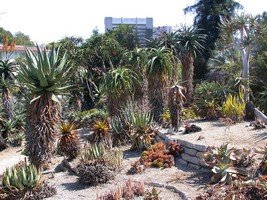 tree aloes growing on the UCLA campus, California, in summer
tree aloes growing on the UCLA campus, California, in summer
Aloe africana- this is a South African tree (as are about 90% of all tree aloes) and grows up to about 6'-10' tall. The leaves of this tree a bit on the 'disorderly' side being generally recurved but rarely symmetrical and neat. The leaf color is unusual being a grey-green to purply-green and lined with sharp red teeth. Each tree retains some dead leaves at least covering much of the trunk, and these skirts are exceptionally disorganized making the trees themselves perhaps less than ideally ornamental. The inflorescences (entire flower) are unbranched with long, narrowly conical racemes (the actual part with the flowers) of bright yellow-orange. The lowest, opening flowers are uniquely upturned, making it easy to tell this tree aloe, while in bloom, from all others. Though typcially a solitary tree, in cold areas where some frost/freeze damage has occured, this aloe can branch at the damage points. But in nature it is always an non-branching tree. This is a relatively slow growing species and is moderately rare, though available through most specialty succulent nurseries. These plants need very little extra care- just sun, heat and water.
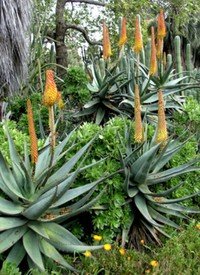 Aloe africanas in winter, southern California. Note the flowers are widened near the bottom- this is typical of this species
Aloe africanas in winter, southern California. Note the flowers are widened near the bottom- this is typical of this species
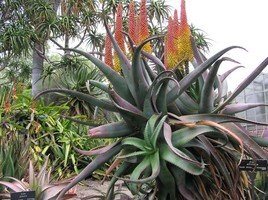 This is a multiheaded tree in winter. This tree was damaged, probably by a severe freeze a while back, and that is why it is branching. However, this is abnormal for this species
This is a multiheaded tree in winter. This tree was damaged, probably by a severe freeze a while back, and that is why it is branching. However, this is abnormal for this species
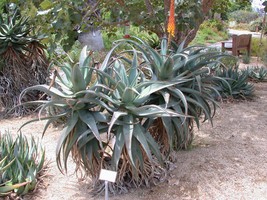 Younger trees growing in the UC Irvine gardens, California
Younger trees growing in the UC Irvine gardens, California
Aloe alooides- another South African species growing as tall as 6' with very long, trailing (often touching the ground), deeply channeled, bright green leaves. Each crown consists of a large number of leaves, and the trunks are also concealed by the skirts of dead, retained leaves giving an overall 'mound' effect to the whole plant. The leaves are lines with tiny, but brightly colored red teeth. Flowers are uniquely brilliantly yellow and unbranched (though may be as many as 5 pre tree) tall spires of very compact racemes that cover about 80% or more of each inflorescence. The flowers tend to open on the sunny side before the other side giving the flowers a bicolor look of yellow and lime green (unopened flowers). This is one of the most beautiful shorter tree aloes and make excellent landscaping specimens. Aloe alooides are somewhat slow-growing trees. This species is fairly rare but available from several internet specialty nurseries. This is also a farily care-free species with few special needs.
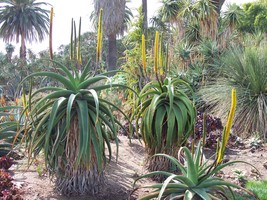 Colony of trees growing in the Huntington Gardens, southern California in winter
Colony of trees growing in the Huntington Gardens, southern California in winter
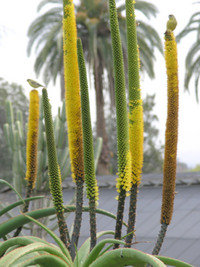 Close of of flowers showing asymmetrical pattern of opening (with the side facing the sun opening first)
Close of of flowers showing asymmetrical pattern of opening (with the side facing the sun opening first)
Aloe comosa is another South African species and a very slow growing plant. Most growers of this species rarely get to see it grow to its full potential and mature aloes are fairly rare in cultivation in the US. However it is an outstanding landscape tree, once it becomes a tree, having flat, somewhat upcurved/ outcurved leaves that usually have a lot of pink and turquoise in them. These have the potential of growing to over 6' tall, the stems usually completely covered in dead leaves, and topped with a large, oversized crown of pale, colorful leaves. Inflorescences are unbranched, but multiple and grow up to 6' tall themselves, being topped with narrowly conical pale pink racemes that cover about 1/2 the lenght of each inflorescence. This is one of the rare summer blooming solitary tree aloes. Plants are not difficult to find on line, but larger plants are very rare and costly. This species seems to resent a lot of summer water, so best to water this one sparingly, particularly when small, as they can rot easily on hot days.
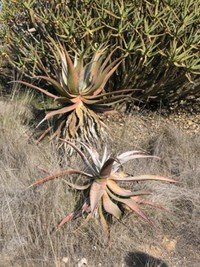 several maturing plants in private garden landscape, southern California
several maturing plants in private garden landscape, southern California
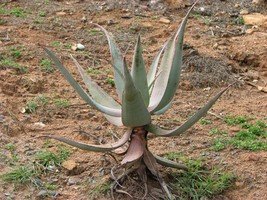 'young' plant (probably 10 years old or more, though) growing in private garden, southern California
'young' plant (probably 10 years old or more, though) growing in private garden, southern California
Aloe excelsa- this is one of the tallest of the South African solitary tree aloes, growing up to18' tall or taller. Young plants can be viciously spiny, but as they mature, the leaves lose most, if not all spines except for the sharp, stout red-brown teeth along the leaf margins. The leaves of this species are a dull green to red-green and either project straight out laterally or recurve down around the trunk. Lower trunks have a thick skirt of dead leaves, but as trees get very tall, the lowest trunk sections are bare. Older plants can be difficult to tell apart from Aloe ferox, which can have similarly colored flowers and leaves and can be similarly tall. However the flowers of Aloe excelsa tend to have a bit of a 'swoop' to them and the racemes cover less than half the length of the inflorescence (Aloe ferox flowers are straight up and down and the racemes cover 80% or more of the inflorescences). The flowers of this species are exceptionally elegant and brilliantly colored being made up of compact columnar racemes or red, orange or yellow. These plants are fairly commonly available at most specialty nurseries and even sometimes at general plant stores. Aloe excelsa is not a needy plant and fairly easy to grow.
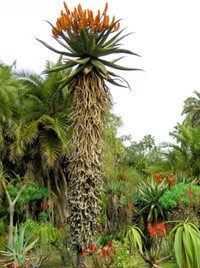 this tree has about 15' of trunk, growing in winter, southern California
this tree has about 15' of trunk, growing in winter, southern California
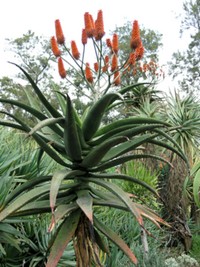 another plant in winter
another plant in winter
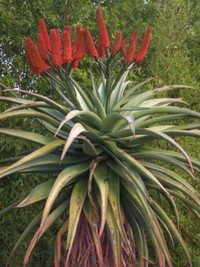 close up showing the flowers and how they have a bit of curve near the bottom of the racemes (colored flowering parts)
close up showing the flowers and how they have a bit of curve near the bottom of the racemes (colored flowering parts)
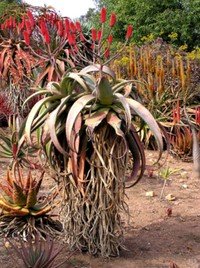 plant with exceptionally recurved leaves in a private garden, southern California
plant with exceptionally recurved leaves in a private garden, southern California
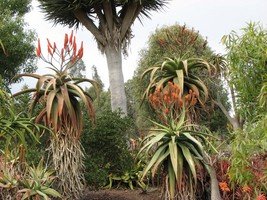 three different colored flowers on these three trees in southern California
three different colored flowers on these three trees in southern California
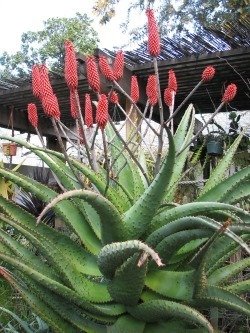 Some plants retain their spines into adulthood
Some plants retain their spines into adulthood
Aloe ferox (the Cape Aloe)- this is probably the most commonly grown non-branching tree aloe, also from South Africa. This is a massive plant, having extra-large, heavy, flattish leaves that either stick straight out, or recurve down elegantly in the KwaZulu form of this plant, also known as Aloe candellabrum. This tree can grow up to 20' tall and is a relatively fast grower. Tall, older plants are somewhat prone to blowing over, particularly in wet, clay soils which seem to retard deep, strong root growth. Trunks are covered with dead leaves as in most of the other tree aloes. Young plants can be heavily armed with leaf spines, but most older plants have spineless leaves, save the large, dark brown teeth along the leaf margins. Aloe marlothii is a closely related species, and young Aloe ferox plants are nearly impossible to tell apart from this one. Mature plants of Aloe marlothii retain their leaf spines and have even more massive, turquoise leaves and very different flowers in general... but there is a form of Aloe marlothii from KwaZulu land (once called Aloe spectabilis) that is very hard to tell apart from Aloe ferox. This form of Aloe marlothii has spineless leaves and relatively upright bicolored flowers that have a bit of a 'swoop' near the bottom of the racemes, which Aloe ferox racemes do not have. Still, telling these two apart can be a chore even for aloe experts. The flowers of Aloe ferox come in a large variety of colors, from deep red, to red orange, orange, yellow and even white. The inflorescence of this species is always branched and the racemes are straight up and down, covering most of the inflorescence about the branching part. The racemes are compact, cylindrical shapes, very similar but somewhat less compact than those of Aloe excelsa. Aloe ferox are common even at garden outlet centers and are very easy, care-free plants to grow in the right climates.
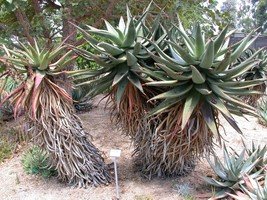 group of plants in summer, southern California
group of plants in summer, southern California
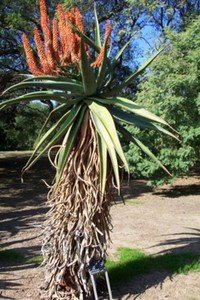 flowering in mid winter, Los Angeles arboretum, southern California
flowering in mid winter, Los Angeles arboretum, southern California
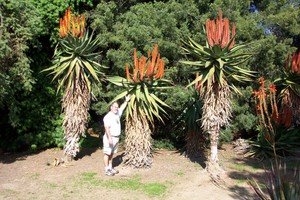 showing scale of these larger plants- this is the form referred to as Aloe candelabrum
showing scale of these larger plants- this is the form referred to as Aloe candelabrum
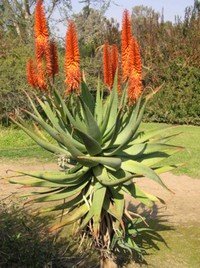 winter in southern California
winter in southern California
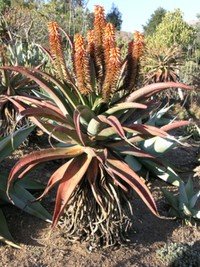 another flower color variation
another flower color variation
Aloe khamiensensis- some books do not include this in the tree aloe category as it is so slow growing many plants hardly attain any height at all in the wild. However, in cultivation this plant can grow up to 10', though it may take decades to get there. Some individuals are known to branch, but that is a very rare occurence. This aloe has a relatively smaller head of leaves in terms of diameter, than do most of the other tree aloes. Most of leaves are flattish and have an upright curve, though, with age, they start to droop and become part of the dense petticoat that covers a small portion of the trunk (most of the trunk of taller plants is bare). Inflorescences are branched and topped with somewhat compact, conical racemes of red-orange flowers covering about a third or less of the inflorescence length. This is an uncommon species and even hard to find at specialty nurseries all the time. Additonally, it can be a touchy plant, prone to suddenly die without warning. Overwatering can reportedly be a problem with this species.
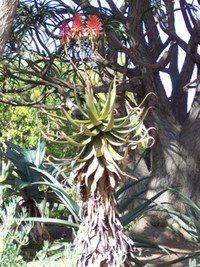 winter flowering plant, southern California
winter flowering plant, southern California
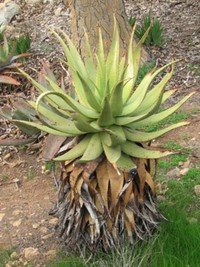 this plant is probably at least 10 years old, and still only about 4' tall overall
this plant is probably at least 10 years old, and still only about 4' tall overall
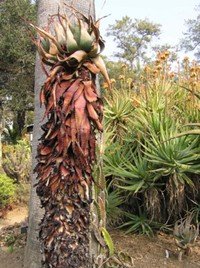 old and somewhat unhealthy specimen with thick petiocoat of dead leaves, southern California
old and somewhat unhealthy specimen with thick petiocoat of dead leaves, southern California
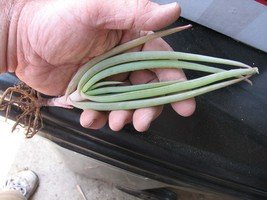 seedling of this rare plant- probably 15 years from forming a trunk
seedling of this rare plant- probably 15 years from forming a trunk
Aloe lineata is another South African aloe, but also one few growers get to appreciate as a tree aloe. In the wild this is always a solitary plant, but in cultivation, for some reason, most all plants sucker. As these plants age, most of the suckers die off, but some large, suckering plants exist in cultivation in southern California. This plant eventually can grow up to 6' tall or more, but not for many decades. Mature plants have almost comically stout stems for how short the tree is, and only the uppermost trunks are covered with dead leaves. The leaves of this species form a dense rosette of blue-green to reddish straight, flat very well armed and lined leaves. The teeth along the edges are red-brown and some of the sharpest of all tree aloes. Flowers consist of solitary inflorescences with relatively thick, conical pink to red racemes that only seem to form into mature flowers as they lower flowers open and start drooping down. There are two forms of this aloe and the more commonly available one, Aloe lineata var. muirii, is a winter flowerer. The other variety is one of the few solitary tree aloes that bloom primarily in the summer. This is a relatively common species of aloe, though most sold at garden outlet centers are rarely labeled correctly, if at all. This plant resents watering from overhead and rots easily in summers with such watering practices. Winter rains do not seem to be a problem, however.
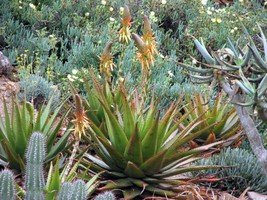 rare solitary plants in southern California. These plants are winter flowerers (Aloe lineata var muirii)
rare solitary plants in southern California. These plants are winter flowerers (Aloe lineata var muirii)
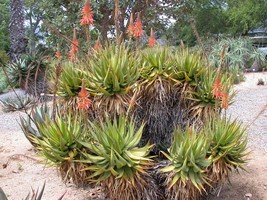 This is a more common sight- the suckering form of this plant. This is the less common variety, blooming in late summer, southern Calfornia
This is a more common sight- the suckering form of this plant. This is the less common variety, blooming in late summer, southern Calfornia
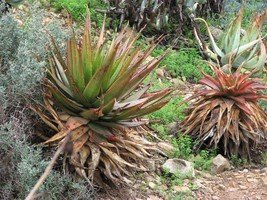 more larger Aloe lineata muiriis in southern California
more larger Aloe lineata muiriis in southern California
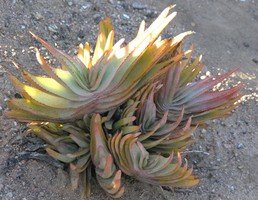 the look of an Aloe lineata seedling in cultivation (obviously not a solitary plant)
the look of an Aloe lineata seedling in cultivation (obviously not a solitary plant)
Aloe littoralis (the Mopane Aloe), yet another South African tree aloe, this is another slow grower though eventually gets as tall as 9'. This is an ornamental species with pale blue-green, spotted, straight, upright leaves. The leaves are lined with red-brown teeth, each on a whitish base. Inflorescences are about 3' tall and highly branched with open, conical racemes of red-pink, with a hint of yellow at the mouth of each flower. This is another summer bloomer. It is generally an easy grower with even young, pre-trunking plants making flowers. However it is not a common species and most plants have to be obtained from specialty growers.
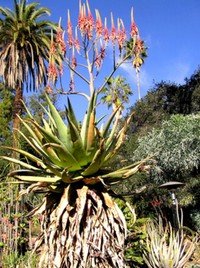 this plant, in the Huntington Gardens, southern California, is blooming in mid summer
this plant, in the Huntington Gardens, southern California, is blooming in mid summer
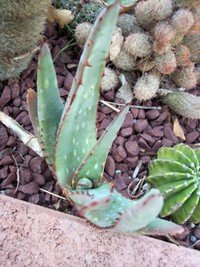 seedling in southern California
seedling in southern California
Aloe martlothii (the Mountain Aloe)- this is considered the big daddy of the solitary tree aloes, though really just a tiny bit more bulky looking than Aloe ferox. This plant is known for its massive head of stiff, straight, wide spiny, turquoise to pale grey-green leaves. These become particularly top heavy and trees can blow over if grown in clay soils. Flowers of the normal form are uniquely swooping, multibranched and come in a variety of colors from orange (the most common color) to red, white or bicolored yellow-red or white-red (most bicolored forms are of the Aloe spectabilis variety from KwaZulu Land). The plants with swooping flowers have what appear to be one-sided racemes in which all the flowers grow up, even from the down side. These inflorescences can be 5'-6' wide and spectacular. Aloe spectabilis flowers are more typically up and down with only a bit of swoop at the bottom, but the flowers still tend to grow mostly on one side rather than the typical symmetrical 360 degree look of most other tree aloe flowers. These Aloe spectabilis trees also tend to have less spiny leaves, if any at all, and they are hard to distinguish from Aloe ferox. This species grows up to 20' or more and much of its trunk will be covered with dead leaves. It is a common species of aloe and sold at most southern California nurseries, or anywhere the climate is permitting.
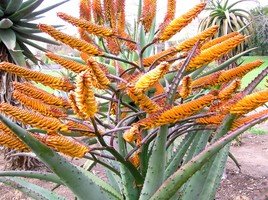 this is a shot of the more typical flowering form of this plant. Note the flowers all point upwards. This shot also shows the typical leaf color and presence of spines
this is a shot of the more typical flowering form of this plant. Note the flowers all point upwards. This shot also shows the typical leaf color and presence of spines
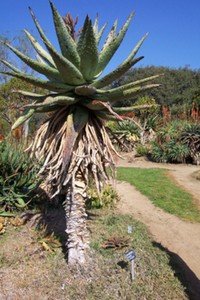 typical plant in summer, southern California, at the Los Angeles arboretum
typical plant in summer, southern California, at the Los Angeles arboretum
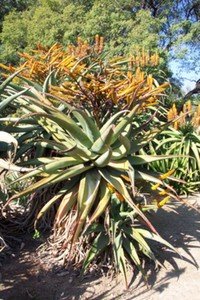 Plants in winter, southern California
Plants in winter, southern California
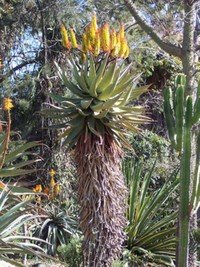 This form is the one that used to refered to as Aloe spectabilis, with the bicolored more upright flowers
This form is the one that used to refered to as Aloe spectabilis, with the bicolored more upright flowers
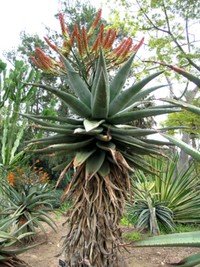 another bicolored flower, but with a more typical inflorescence shape
another bicolored flower, but with a more typical inflorescence shape
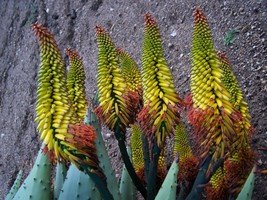 close up of the Aloe spectablis flowers (this plant fell over, so that's why it looks like it's on the ground... it is).
close up of the Aloe spectablis flowers (this plant fell over, so that's why it looks like it's on the ground... it is).
Aloe munchii- this is more recent addition to the available cultivated tree aloes and is a very easy and attractive species (at least in a Mediterranean climate). It is a relatively slight species with blue-green leaves the tend to grow upward more than laterally and have a somewhat flexible, 'user-friendly' characteristic. This aloe can grow up to fifteen feet in height, but I have never seen one that tall. But it is a relatively fast growing species and mine went from a seedling to a flowering short tree of three feet in just a few years. Flowers are a nice deep orange and the racemes are nearly spherical. This is a native of Zimbabwe.
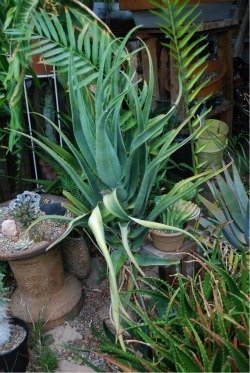
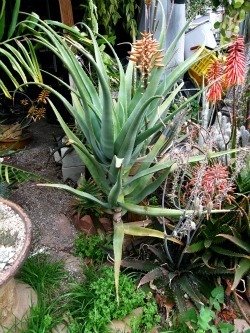
Aloe munchii above (mine in summer, left) and flowering (right) in winter
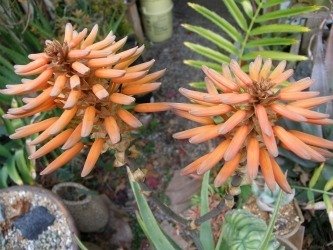 typical flowers of Aloe munchii
typical flowers of Aloe munchii
Aloe pluridens (the French Aloe)- Compared to most of the other South African aloes, this is a delicate species, having much smaller leaves and trunks than most of the other non-branching aloes. It generally grows 10' to 15' and has a relatively thin trunk, sometimes only 3" or so in diameter. In the wild this is a solitary tree.. however, many cultivated plants sucker, and some profusely. It is discussed here in this article because it is supposed to be a solitary aloe. The leaves of this plant are particularly ornamental being very symmetrical, recurved and thin, growing in a perfect spiral if viewed from above. The leaves themselves closely resemble those of the very common aloe, Aloe arborescens, in both size and shape (though some older, larger plants develop much larger leaves than Aloe arborescens). Aloe pluridens is a particularly good landscape aloe for smaller gardens as it takes up very little room relative to the other tree aloes. This is a relatively rare species in cultivation, but readily available at specialty nurseries.
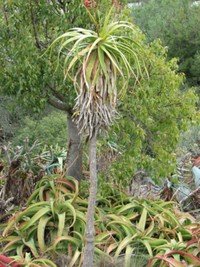 this is the more typical look of this species, as a solitary plant. However, this plant, though it may look large in the photo, is only about 7' tall
this is the more typical look of this species, as a solitary plant. However, this plant, though it may look large in the photo, is only about 7' tall
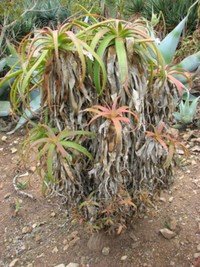 some plants end up looking like this, though, suckering like crazy. This plant is only 5' tall
some plants end up looking like this, though, suckering like crazy. This plant is only 5' tall
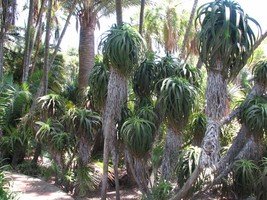 Part of an old and amazing colony of plants growing in Lotusland, Santa Barbara, California
Part of an old and amazing colony of plants growing in Lotusland, Santa Barbara, California
 Close up of crown of Santa Barbara plant
Close up of crown of Santa Barbara plant
Aloe rupestris- this is another aloe that, in its native South Africa, is nearly always a solitary species. However, in cultivation, at least in the US, it is nearly invariably a suckering plant (so more than likely all the plants in the US arise from a single rare suckering form). In South Africa this is one of the tallest of the aloes growing to 30' and is one of the fastest growing aloes, too. The cultivated suckering form is only a moderately fast grower and there is no telling how tall it will grow at this time, but probably at least to 20'. Leaves are a dull green to deep green and armed with sharp red-brown, somewhat hooked teeth. The leaves are stiff and spreading with only some recurving characteristics. Flowers are branched with short, dense, almost wooly looking racemes of yellow-orange, though sometimes red or yellow. This is a moderately rare species usually only available at specialty nurseries. True solitary forms are extremely rare in cultivation, at least now (2007).
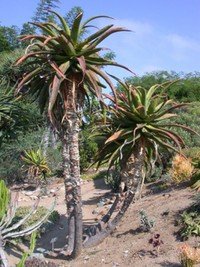 these trees are growing in Quail Gardens, Encinitas, California. These are possibly a suckering tree, or 4 closely planted solitary trees (less likely) but are some of the oldest Aloe rupestris in California
these trees are growing in Quail Gardens, Encinitas, California. These are possibly a suckering tree, or 4 closely planted solitary trees (less likely) but are some of the oldest Aloe rupestris in California
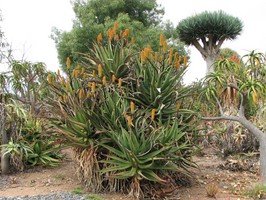 winter blooms on this suckering plant in private garden, southern California
winter blooms on this suckering plant in private garden, southern California
Aloe sabaea- this is one of the few available tree aloes in cultivation NOT from Africa (from Yemen). It is a curious tree aloe, growing up to about 10', if that, and having a relatively sparse head of leaves (sometimes only 6-8), most that droop charactersitically almost straight down. The leaves are thick, wide and gently tapering, fleshy pale green to yellow green and lightly armed with pale teeth along the margins. Stems are markedly thin, making these trees seem inordinately top heavy. There is only a few dead leaves in the skirt below the crown and most of the stem is usually bare. Flowers are multibranched and racemes are extremely open and consist of multicolored flowers of either red or orange and yellow. Aloe sabaea has surprising cold tolerance considering its ultra-tropical latitude, but it is not as hardy as most of the South African solitary tree aloes (damaged at about 27F). It is a slow plant and only available intermittently through specialty nurseries or on line.
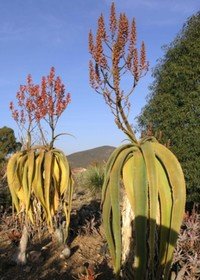 several older trees blooming in winter, private garden, southern California
several older trees blooming in winter, private garden, southern California
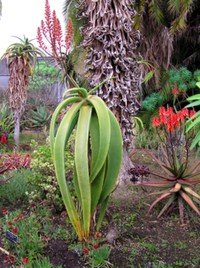 younger tree showing typical drooping leaves, winter
younger tree showing typical drooping leaves, winter
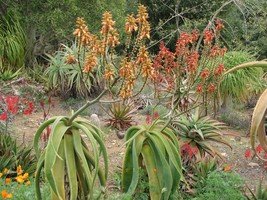 two different flower colors, winter, private garden, southern California
two different flower colors, winter, private garden, southern California
Aloe speciosa (the Tilt-Head Aloe)- probably one of the most spectacular sights is a colony of these in full bloom in winter. These plants grow to about 18' tall at the most (usually much less) and sometimes branch dichotomously, though this happens maybe only half the time. So this species could be discussed here, or in part two, but since it doesn't always branch, it is discussed here. These trees have uniquely soft, pliable (almost rubbery) flattened pale sea-green leaves arising from a 'tilted' crown (oriented laterally or at an angle). Flowers are branched but very short except for the long, conical dense, thick, white to pink-red racemes. This is a moderately common species, even available periodically at retail nurseries. It is a moderate grower and one of the less cold hardy of the South African solitary tree aloes (down to around 26F).
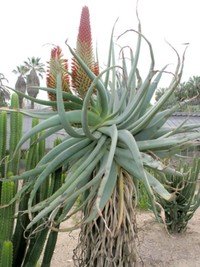 showing typical tilted head of leaves and flowers in winter
showing typical tilted head of leaves and flowers in winter
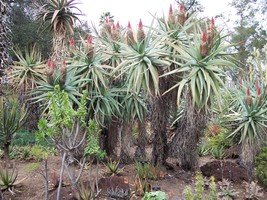 group of taller trees in Huntington Gardens, mid winter
group of taller trees in Huntington Gardens, mid winter
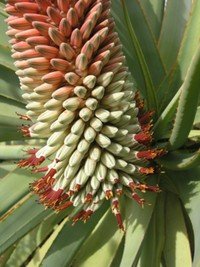 close up of incredible flowers of this species
close up of incredible flowers of this species
Aloe suzannae- though technically this is a branching aloe, too, most individuals do not branch, at least in the life time of the grower. Aloe suzannae is a Madagascan aloe and nearly extinct in the wild. This is an extremely slow growing aloe, taking many many decades to reach its potential height of over 20'. Aloes of this height simply do not exist in cultivation, at least in the US at this time (2007). The leaves of this plant are nearly tubular, upright and pliable, almost rubbery, and a pale brownish-pink to pale turquoise. There are teeth along most of the leaf margins, but they are small and pale, nearly insignificant. Plants will flower before forming any stem, but this is an aloe that only flowers periodically and only when conditions are perfect. Most maturing plants will flower maybe once or twice every 5-10 years. Flowers are solitary and enormous, consisting of a 6' open raceme of literally thousands of individual cream-colored flowers on a very short, stout pedicle. Flowers last well over a month, opening up only at the very end of that period. This is not necessarily the most elegant or ornamental of the tree aloes, but still an imposing and interesting specimen. These plants are a bit more prone to rot if overwatered, particularly in summer, than are most other tree aloes. And cold hardiness ends at about 27F. Aloe suzannaes are relatively rare, particularly of any size, but available at many specialty nurseries.
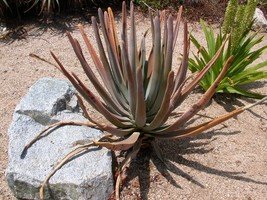 a particularly nicely colored specimen
a particularly nicely colored specimen
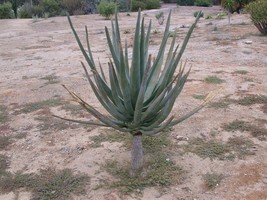 one of the few trunking plants in southern California, Fullerton Arboretum
one of the few trunking plants in southern California, Fullerton Arboretum
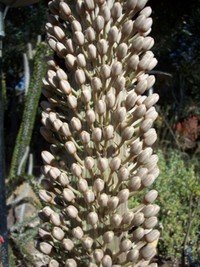 flower detail
flower detail
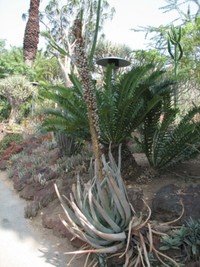 stressed plant after over 6 weeks of being in flower, now forming fruit, Huntington Gardens, California
stressed plant after over 6 weeks of being in flower, now forming fruit, Huntington Gardens, California
Aloe thraskii (the Dune Aloe)- this is a classic-looking tree aloe, growing up to 18' tall and topped with a large head of long, pale green, markedly recurving, channeled leaves. Young plants look a bit like a pale version of Aloe alooides with the long, recurved leaves touching the ground, but then they grow a lot taller. Flowers are very different from Aloe alooides having many branches and being only 3' tall with compact, cylindrical yellow-orange flowers covering up less than half the inflorescence. This is a moderately fast growing species and a pretty easy one to grow. Though not available through most retail nuseries, it is not a difficult aloe to find at the specialty sources.
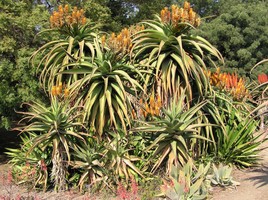 large colony of plants in the Los Angeles Arboretum, winter
large colony of plants in the Los Angeles Arboretum, winter
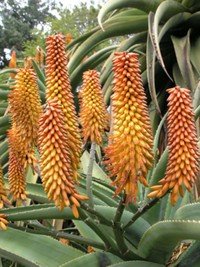 close of flowers, winter
close of flowers, winter
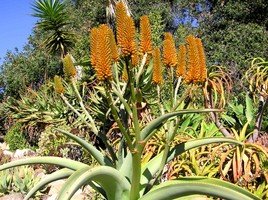 private garden, southern California
private garden, southern California
Aloe vaombe is probably one of the fastest growing and attractive aloes of the group, having bright olive-green to deep green, very deeply channeled recurving leaves. This Madagascan aloe grows to about 10' but takes only 5-6 years to grow half that height and start flowering. The leaves of Aloe vaombe are somewhat thin in cross section and secrete a curious brilliant yellow-green ooze when cut, that tends to stain everything it touchs a deep purple. Flowers are highly ornamental being branched with very open racemes of scarlet red flowers. Though it is a relatively cold sensitive species (temps below 28F will damage the leaves) it is an easy plant to grow and an excellent landscape specimen. This is also one of the easiest aloes to grow from seed with seedlings seemingly particularly resistant to rot. Additionally this is one of the few solitary tree aloes that performs well in tropical climates, such as southern Florida. It is still a somewhat rare aloe in nurseries, but readily available from specialty sources.
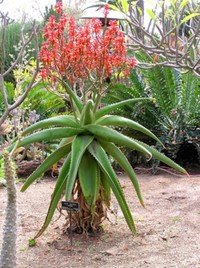 mature plant, Huntington Gardens, southern California, winter
mature plant, Huntington Gardens, southern California, winter
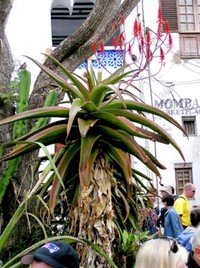 plant growing happily in Tampa, Florida
plant growing happily in Tampa, Florida
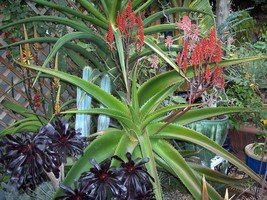 this plant was grown from seed that germinated 5 years earlier, southern California
this plant was grown from seed that germinated 5 years earlier, southern California
Aloe vaotsanda- this is a relatively newly available Madagascan aloe to cultivation so few if any mature, tall trunking plants exist outside of Madagascar. As a young plant it is a moderately fast grower and quickly forms a mound of long, tapering, often twisting, deeply channeled, pale turquoise to reddish and bright green leaves. Eventually plants over 5' tall start showing a bit of trunk below the leaves, but until then, plants have the look of being supported by the leaves. The marginal teeth are pronounced but not terribly sharp. Plants probably grow up as tall as 10' or more, but it is too new in cultivation to know how tall they will get outside the wild. The short, branching inflorescences are unusual in not only being bicolored (deep red but opening yellow from the base to the tip) but also the short racemes point nearly horizontally in all directions. Unlike what occurs with Aloe marlothii's somewhat horizontal flowers that have 'one-sided' racemes, the racemes of Aloe vaotsanda are symmetrical 360 degrees. Flowering occurs a bit late in the winter, sometimes into early spring. This is still a rare aloe in cultivation, but periodically shows up at specialty nurseries. It is a beautiful aloe and one should try to get one if the opportunity arises.
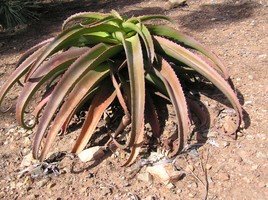 seedling in private garden looking like an octopus- typical look for young plants
seedling in private garden looking like an octopus- typical look for young plants
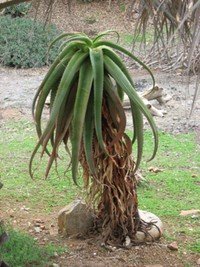 older plant starting to show skirt of dead leaves
older plant starting to show skirt of dead leaves
Other tree aloes, such as Aloe angelica and Aloe helenae could be discussed here, but they are so rare in cultivation that there is little if any experience with these two species in the US. Aloe vryheidensis is another 'tree aloe', but rarely if ever grows as tall as it supposedly does in South Africa, so is also left out here. Even less common in cultvation, but also considered solitary tree aloes are Aloe argyrostachys (a distichous species from Madagascar), Aloe purpurea (aka Lomatophyllum purpurea) from the Mauritius islands, Aloe alexandrei (also was once in the Lomatophyllum genus) from Comoro Islands off Madagascar, Aloe peyrierasii (another ex-Lomatophyllum species from Madagascar), Aloe exima from Madagascar, Aloe rupicola from Angola, Aloe ballyi from Kenya and the closely related Aloe elata from Tanzania. All are extremely hard to find in cultivation and I have no photos of any of these as mature plants.
Tree aloes are among the cream of the crop in terms of southwestern landscaping trees. If you live in the right climate, or want a beautiful and exotic potted plant in a different climate, you should definitely consider growing these trees.
Copyright © www.100flowers.win Botanic Garden All Rights Reserved